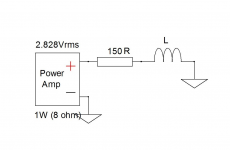Actually, this CAN be done with good accuracy with other equipment (an oscillator or some audio-frequency sine wave source), some passive components (resistor and/or capacitor) and an AC voltmeter, but it takes some effort to set up, measure voltages, and then calculate the inductance value. This takes knowledge of AC circuits analysis, or at least looking up the equations and learning how to apply them (knowledge of basic algebra helps here). Googling this:I hadn't thought of removing coils from a larger inductor. What's the easiest way to measure inductance without an LCR meter?
calculating inductance from impedance
brings up some useful sites.
We did this kind of thing decades ago (when I was in college), because it was "the only way to do it." Digital electronics was becoming popular at the time and contains just the magic sauce to automate measurements and calculations such as this. At one of my earlier jobs I used an HP inductance meter with an LED display. I don't remember the model number.
I got a BK-878 about 19 years ago, and still have and use it.
All that manual stuff is instructive and gets the right answer, but it's tedious. By the time you do measurements manually with one or two inductors for a pair of crossovers, and you think you'll ever wind or modify inductors yourself again, you'll be saving up for an LCR meter.
Precise method for measuring inductance
I have found some other suggestions for measuring inductors;
1. From diyaudio member Lojzek which reads as follows
"I have tried a simple way of measuring inductance with only a signal generator ( 1 kHz from a CD), output amp voltage 2,828Vrms, a resistor (150R) in series with unknown inductor and it worked reasonably accurate for a 0,56mH(air) and 5,6 mH(ferrite) coils. Measure the voltage drop with a multimeter across each part and use the following formula.
L(mH)=(Vl*R)/(Vr*6,28)
Vl=voltage drop on L
Vr=voltage drop on R"
---------------------------------------------------------------------------------
2. Using LIMP from arta and using jig for measurement of impedance
---------------------------------------------------------------------------------
Since I do not have a reference inductor value, my question is how precise are the above methods?
I have found some other suggestions for measuring inductors;
1. From diyaudio member Lojzek which reads as follows
"I have tried a simple way of measuring inductance with only a signal generator ( 1 kHz from a CD), output amp voltage 2,828Vrms, a resistor (150R) in series with unknown inductor and it worked reasonably accurate for a 0,56mH(air) and 5,6 mH(ferrite) coils. Measure the voltage drop with a multimeter across each part and use the following formula.
L(mH)=(Vl*R)/(Vr*6,28)
Vl=voltage drop on L
Vr=voltage drop on R"
---------------------------------------------------------------------------------
2. Using LIMP from arta and using jig for measurement of impedance
---------------------------------------------------------------------------------
Since I do not have a reference inductor value, my question is how precise are the above methods?
Attachments
How good your result is depends on the accuracy of all the other components and measurements involved. Worst case, the error budget adds up directly. I'll assume the 1kHz frequency is right on (or within 0.1%). With a 1 percent resistor and a meter that measures AC voltage within 2 percent, you can be reasonably sure your measured-and-calculated inductance value is within 5 percent.
- Status
- This old topic is closed. If you want to reopen this topic, contact a moderator using the "Report Post" button.
